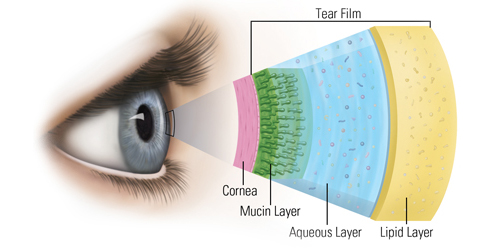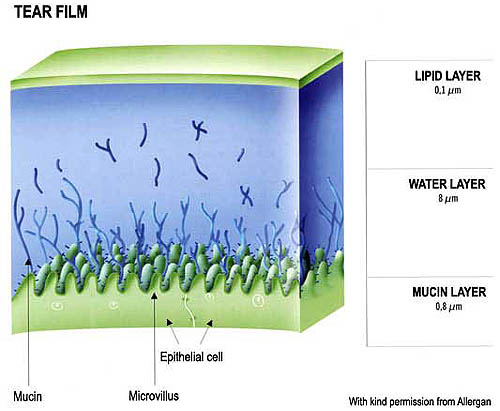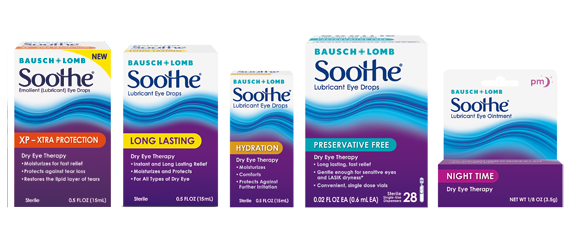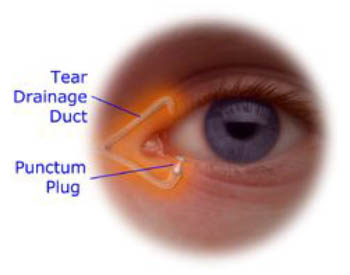As many as 33 million Americans, half of them over age 50, may be experiencing symptoms of an irritating condition known as dry eye. While there are simple and generally effective forms of treatment, the majority of those suffering from dry eye have not consulted an eye doctor.
If left untreated, dry eye can be more than just irritating or uncomfortable. Over a period of time, excessive dry eye can cause damage to eye tissue. Dry eye can also make wearing contact lenses more difficult due to the irritation of the cornea and the greater chance of eye infection.
Dry eye symptoms can result from the normal aging process, exposure to environmental conditions, problems with normal blinking, or medications such as antihistamines, oral contraceptives, or antidepressants. Dry eye can also be symptomatic of general health problems or can result from chemical or thermal burns to the eye.
The normal eye produces tears that are composed of three different layers:
The oily outer layer
The watery middle layer and
The mucus inner layer.

All three layers must be produced in the proper formulation for tears to properly lubricate the outer surface of the eye. Dry eye occurs when the eye doesn’t produce the necessary quantity of tears or produces poor quality tears which lack the proper composition and evaporate quickly.

SYMPTOMS
- Red eyes
- Burning eyes
- Itchy eyes
- Scratchiness
- Tearing eyes
- Sensitivity to light
- Watering eyes
- Gritty sensation
- Blurred vision
Ironically, one of the symptoms of this relatively common eye disorder is excessive watering of the affected eye. Watering eyes is a natural response to irritation of the cornea by tears that have the wrong chemical composition. This is one reason why so many people with the disorder do not consider the possibility that the term dry eye might apply to them.
Other symptoms include scratchy, dry, irritated, or generally uncomfortable eyes. Red eyes, burning eyes, the sensation of having a foreign body in the eye, or blurred vision may also result from the problem. When looking in a mirror, the eyes may seem to have lost their normal clearness and luster.
CAUSES
- Age
- Medications
- Antihistamines
- Oral contraceptives
- Antidepressants
- Decongestants
- Certain heart medications (beta-blockers)
- Diuretics
- Glaucoma medications
- Wind
- Sun
- Cold
- Indoor heating and air conditioning (low humidity)
- Computer screens
- High altitudes
- Systemic arthritic conditions or autoimmune disorders
TREATMENT
- Artificial tears (OTC-many different kinds such as SootheXP)
- Restasis (prescription)
- Prescription steroid eye drops
- Puntal plugs (plugging up the drainage tear ducts, which is reversible)
- Oral doxycycline
- Warm compresses on the lids
- Lid wash with baby shampoo
- Home humidifier
Over-the-Counter (no Rx required) SOOTHE is a very good option for low level dry eye symptoms. It comes in several formulations. It even comes in an ointment that can be instilled at night to help rejuvenate eye tissues while you sleep.

Some causes of dry eye cannot be permanently cured but can be effectively managed. The initial treatment most likely to be recommended is the use of over-the-counter artificial lubricating eye drops. There are also soothing ointments that may be applied at bedtime. Secondary treatment would be the addition of Restasis.

Patients who live in a dry climate often benefit from the use of a humidifier in their home or office. For more severe cases of dry eye, we may recommend the insertion of tiny, removable plugs in the tear drainage canal of each eye. This slows down the drainage and evaporation of tears from the surface of the eye to provide more natural lubrication. This procedure is reversible and painless; it takes about 5 minutes and is done in the office. Early detection of dry eye leads to more effective treatment and the prevention of serious damage to your eyes. Dry eye is an easily managed eye disorder.

